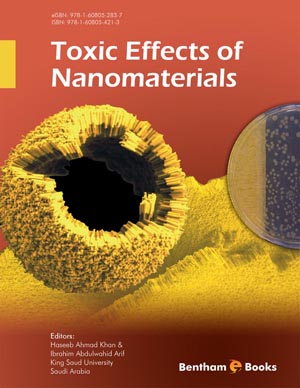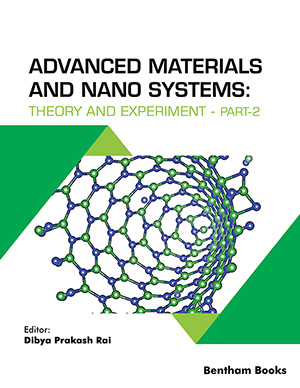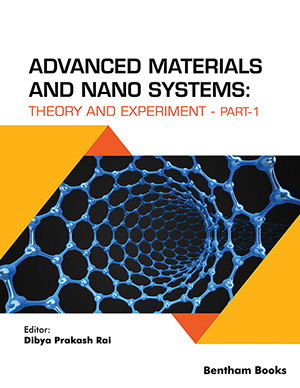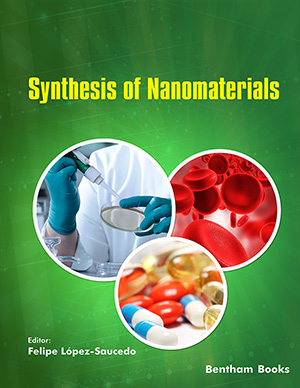About the Editors
Page: i-i (1)
Author: Haseeb Ahmad Khan and Ibrahim Abdulwahid Arif
DOI: 10.2174/97816080528371120101000i
Preface
Page: iii-iii (1)
Author: Haseeb Ahmad Khan and Ibrahim Abdulwahid Arif
DOI: 10.2174/978160805283711201010iii
List of Contributors
Page: iv-vii (4)
Author: Haseeb Ahmad Khan and Ibrahim Abdulwahid Arif
DOI: 10.2174/9781608052837112010100iv
Nanoparticle-Induced Toxicity: Focus on Plants
Page: 3-27 (25)
Author: Anna Speranza and Kerstin Leopold
DOI: 10.2174/978160805283711201010003
PDF Price: $15
Abstract
Nanoparticle technology offers a large array of applications also in plants, for either plant biology research or agricultural practice. Indeed, plants are at the base of any ecological web, in both natural and artificial ecosystems; nanoparticles of various origins, natural as well as anthropogenic or engineered, are being increasingly released into the environment. Therefore, assessment of possible risks is urgent before nanoparticles become more and more ubiquitous in every aspects of life. The present chapter critically reviews recent knowledge on phytotoxicity of nanoparticles, considering both lower and higher plants.
Plants as Indicators of Nanoparticles Toxicity
Page: 29-52 (24)
Author: Mamta Kumari, Vinita Ernest, Amitava Mukherjee and N. Chandrasekaran
DOI: 10.2174/978160805283711201010029
PDF Price: $15
Abstract
Increasing application of nanoparticles in consumer products enhances its release into the environment. Plants are the primary target species to work out a comprehensive toxicity profile for nanoparticles. Toxicity profiles of nanoparticles to the plant system, uptake and its subsequent fate within the food chain are not available. The phytoxicological behaviour of silver and zinc oxide nanoparticles on Allium cepa and seeds of Lycopersicum esculentum (tomato), Cucumis sativus (cucumber) and Zea mays (maize) were experimented. The in vitro studies of Allium cepa root tips exposed to a concentration-tested range of 25, 50, 75, and 100 μg ml-1 nanoparticles for 4 h revealed different cytotoxicological effects including mitotic index, chromosomal aberrations, vagrant chromosomes, sticky chromosomes, disturbed metaphase, breaks, and formation of micronucleus. Nanoparticles treated seeds showed reduced germination rate and decrease in shoot and root lengths. Nanoparticles treated seedlings showed reduced shoot and root lengths. The percentage germination of seeds was delayed with increasing concentration of nanoparticles. Though engineered nanoparticles have significant advantage in biomedical applications, it also requires a great deal of toxicity profile on the other side to ascertain the biosafety and risk of using nanoparticles in consumer products.
Cell Life Cycle Effects of Bare and Coated Superparamagnetic Iron Oxide Nanoparticles
Page: 53-65 (13)
Author: Morteza Mahmoudi, Sophie Laurent and W. Shane Journeay
DOI: 10.2174/978160805283711201010053
PDF Price: $15
Abstract
Due to the hopeful potential of nanoparticles in medicine, they have attracted much attention for various applications such as targeted drug/gene delivery, separation or imaging. Interaction of NPs with the biological environment can lead to a wide range of cellular responses. In order to have safe NPs for biomedical applications, the current biocompatibility researches are particularly focused on the severe toxic mechanisms which cause cells death. These mechanisms are apoptosis, autophagy and necrosis, which can also be intricately linked with the cell-life cycle, as there are various check-points and controls in a cell’s life cycle to ensure appropriate division processes. Mechanisms by which toxicants induce cell death by necrosis and apoptosis have been the focus of many biomedical disciplines because it helps us understand toxicity but also provides opportunities for drugs to impact on dysregulation of the cell cycle in diseases such as cancer. Among various types of NPs, the superparamagnetic iron oxide nanoparticles (SPION) are recognized as powerful biocompatible materials for multi-task nanomedicine applications such as drug delivery, magnetic resonance imaging, cell/protein separation, hyperthermia and transfection. This chapter presents overview of the effect of SPION on the cell life cycle.
Safety of Magnetic Iron Oxide-Coated Nanoparticles in Clinical Diagnostics and Therapy
Page: 67-84 (18)
Author: Ângela Leao Andrade, Rosana Zacarias Domingues, José Domingos Fabris and Alfredo Miranda Goes
DOI: 10.2174/978160805283711201010067
PDF Price: $15
Abstract
Most potential benefits of nanotechnology in industrial processes and in medicine are inimitable. The versatility of magnetic nanoparticles (MNP) is mainly due to their small size-induced properties, which govern their ability to readily respond to an external magnetic field and their achievable functionality as bioactive agents. Both of these two characteristics may be built either individually or be suitably combined. However, any potentially harmful consequence of MNPs to the integrity of healthy human tissues must be safely and seriously taken into account. Scientific researcher, commercial manufacturers and government staffs along with all those expertises concerned with eventual pernicious effects of chemical synthetic products on the natural environment increasingly require futher studies on toxicity effects of nanoparticles, particularly as constituents of those materials more often used in commercial products destined to internal medicine therapy or dignostic procedures, or to other less critical toxic principles for humans, such as in daily used over-skin creams and body cosmetics. Regulatory laws on the use or manipulation of toxic products rely on the accuracy and right choice of test protocols to evaluate their real organic safety. Multidisciplinary studies envolving nanomaterials, toxicitivity as well as biomedical and other disciplins will certainly guide the development of advanced and futurely still more biocompatible materials and devices to be used in medical practices.
Hazards of TiO2 and Amorphous SiO2 Nanoparticles
Page: 85-96 (12)
Author: Lucas Reijnders
DOI: 10.2174/978160805283711201010085
PDF Price: $15
Abstract
TiO2 and amorphous SiO2 nanoparticles have been described as ‘safe’, ‘non-toxic’ and ‘environment friendly’ in scientific literature. However, though toxicity data are far from complete, there is evidence that these nanoparticles are hazardous. TiO2 nanoparticles have been found hazardous to humans on inhalation, ingestion and dermal exposure. Ecotoxicity at levels of TiO2 nanoparticles which are expected in the environment has also been found. Amorphous SiO2 nanoparticles appear to be hazardous to humans on inhalation and ingestion and there is some evidence for ecotoxicity of amorphous SiO2 nanoparticles. A main, though not the only, mechanism underlying the hazards of SiO2 and TiO2 nanoparticles may be the generation of reactive oxygen species. In view of the lack of scientific data pertinent to quantification of hazard and risk, a precautionary approach to production and usage of SiO2 and TiO2 nanoparticles has been advocated. Options for hazard reduction, such as coatings for TiO2 nanoparticles, functionalization for amorphous SiO2 nanoparticles and binding of nanoparticles to substrates, and risk reduction, including containment and membrane filtration, are discussed.
Molecular Methods for Nanotoxicology
Page: 97-120 (24)
Author: Lisa Bregoli, Stefano Pozzi-Mucelli and Laura Manodori
DOI: 10.2174/978160805283711201010097
PDF Price: $15
Abstract
This chapter presents the most frequently used methods to study the effect of nanomaterials and nanoparticles on biological systems. The aim of the chapter is not to give a detailed technical description of the protocols, but to present the available techniques that have been adopted for the analysis of potential toxic effect of nanomaterials, and engineered nanoparticles in particular. As nanotoxicology is an extremely new branch of bio-toxicological sciences, the definition of its methods is still in the process of development. In this chapter we describe the main challenges of this process, where the adaptation of classical cytotoxicity and molecular methods has to take into account the unique properties of nanomaterials.
Risks Associated with the Use of Nanomaterials
Page: 121-136 (16)
Author: Sajjad Haider, Nausheen Bukhari and Adnan Haider
DOI: 10.2174/978160805283711201010121
PDF Price: $15
Abstract
Advances in engineering nanostructures with exquisite control of size and shape, their unique properties and broad applications (e.g., probes in ultrasensitive molecular sensing and diagnostic imaging, agents for photodynamic therapy and actuators for drug delivery, triggers for photothermal treatment, and precursors for building solar cells, electronics and light emitting diodes) have made nanotechnology an exciting research area. As the field moves from academic findings to industrial products, concerns have surfaced on the subject of the toxicity of nanostructures. Therefore, it is indispensable to embark on liable development of nanotechnology to develop and use these nanomaterials to meet human and societal needs while making every effort to foresee and alleviate their adverse effects, and unintended consequences. Currently, a complete understanding of the size, shape, composition, and aggregation dependent interactions of nanostructures with biological systems is lacking and thus it is unclear whether the exposure of humans, animals, insects and plants to engineered nanomaterials could produce harmful biological responses. Hence, a new sub-discipline of nanotechnology called nanotoxicology has emerged. There is a keen interest in nanotoxicology research since the processing of nanostructures in biological systems could lead to unpredictable effects. This uncertainty, in combination with the absence of a complete current understanding of the interactions of as-designed nanostructures with biological systems has led to many questions raised by the regulatory agencies and general public to nanotechnology-based products. The focus of this chapter is to update the reader knowledge on the design, synthesis, characterization and in-vitro and in-vivo activities of these nanostructures and define a link between these studies and a better toxicological understanding of nanostructures.
Toxicologic and Environmental Issues Related to Nanotechnology Development
Page: 137-147 (11)
Author: Ibrahim Abdulwahid Arif, Haseeb Ahmad Khan, Salman Al Rokayan, Abdullah Saleh Alhomida, Mohammad Abdul Bakir and Fatima Khanam
DOI: 10.2174/978160805283711201010137
PDF Price: $15
Abstract
This decade has seen revolutionary developments in the field of nanotechnology with newer and diverse applications of nanoparticles appearing everyday. Novel nanomaterials are emerging with different characteristics and compositions for specific applications such as cosmetics, drug delivery, imaging, electronic etc. However, little attention is being paid to understand, assess and manage the environmental impact of nanoparticles. Currently the information about toxicity of nanoparticles and their environmental fate in air, water and soil is severely lacking. Inhalation, ingestion and dermal penetration are the potential exposure routes for nanoparticles whereas particle size, shape, surface area and surface chemistry collectively define the toxicity of nanoparticles. Several studies have shown excessive generation of reactive oxygen species as well as transient or persistent inflammation following exposure to various classes of nanoparticles. Increased production and intentional (sunscreens, drug-delivery) or unintentional (environmental, occupational) exposure to nanoparticles is likely to increase the possibilities of adverse health effects. The major environmental concerns include exposure assessment, biological fate, toxicity, persistence and transformation of nanoparticles. Thus, the novel nanomaterials need to be biologically characterized for their health hazards to ensure risk-free and sustainable implementation of nanotechnology.
Introduction
Toxic Effects of Nanomaterials provides an authoritative work of international experts in the field of nanotoxicology spanning 8 chapters. A key feature of the e-book is a broad coverage of phytotoxicity of nanoparticles, which is largely neglected in many texts. The first couple of chapters of this book deal with the toxicity of nanoparticles in plants. This is followed by a discussion on the toxicities of iron oxide, titanium oxide and silicon oxide nanoparticles. Next, the volume provides a comprehensive review of methodologies used in nanotoxicology surveys. The concluding chapters highlight the risks associated with the use of nanoparticles and the environmental impact of nanomaterials. Such a broad coverage of nanotoxicology renders this book highly beneficial to the scientists from multidisciplinary areas including nanotechnologists, toxicologists, pharmacologists, environmental chemists and biomedical scientists. This book would equally be useful for the individuals advocating for sustainable use of nanotechnology.


 Download PDF Flyer
Download PDF Flyer




 Download PDF File
Download PDF File










